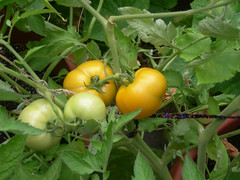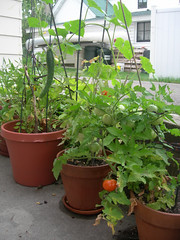A few weeks after I began this blog, I succumbed to peer pressure and did a terrible thing. And I've felt guilty ever since.
This dreadful deed? Dropping the apostrophe in "farmers market" (there, I shudder just looking at it). It may be correct AP style. It may be increasingly accepted. But in my heart I know it's wrong.
I'm a grammar and usage junkie from way back. My mother paid me to check for errors in the galley proofs of one of her books while I was still in elementary school [well, on further reflection, more like 7th grade]. I got (blush) a perfect 800 score on what used to be called the English Composition Achievement Test. My father was a journeyman printer-proofreader, who learned to proofread movable type upside down and backward. Editing skills have been a big part of my career, though my proofreader's eye does tire and miss things sometimes. So this stuff means something to me; I'll readily engage in a 20-minute debate on the finer points of the English language. I am flexible in a number of areas and am not a strict traditionalist by any means. But "farmers market" sticks in my throat.
There was a big debate not long ago about the naming of
Scholars Walk at the University of Minnesota. The no-apostrophe faction won, the prevailing argument being that the walk did not
belong to the scholars, it was merely named in honor of them. That argument doesn't persuade me when it's about scholars and it doesn't persuade me when it's about farmers, though it persuades others. See, for example, a
journalist's discussion of the issue. Here's
another:
Today, the tendency is to drop the apostrophe where once it would have been required. We see this especially in company and organization names. A relatively new distinction has arisen: if the organization is for the benefit of, but not actually owned by a particular group, don’t use an apostrophe. Thus, we have Department of Veterans Affairs, Citizens Insurance, Consumers Energy, and Farmers Market, none of them owned by the group in question. But we’d have a veteran’s benefit check, citizens’ groups, and the farmer’s daughter.
Okay, so there is definitely support for this view. Peer pressure, as I said. And I gave in. But I don't like it, and it's been nagging at me. In my mind, a plural noun is not properly used as an adjective unless it is made possessive. Possessiveness, in grammar, doesn't indicate only ownership; it can also indicate some general relation, a "pertaining to." When you don't want to use a possessive form, you use the singular. We don't say "I'm going to buy a dogs collar," we say "I'm going to buy a dog collar" (or, more elegantly, "I'm going to buy a collar for my dog"!). We don't have employees benefits, we have employee benefits. Or we could, somewhat less elegantly, have employees' benefits, particularly if we're talking about particular employees.
So why do we have Kids Meals? Veterans Day? Farmers markets? Singles bars? That phraseology loses something significant in elegance and precision. I think we could have farm markets, or farmer markets (which sounds odd, but I think that's just because it hasn't happened to become our usual idom), or farmers' markets.
There are some traditionalists who agree with me, like the
Lexington Farmers' Market and the
Australian Farmers' Markets. And in the article linked above on the
Scholars Walk controversy, I see that my favorite newspaper grammarian,
Stephen Wilbers, sides with me on this one -- in part because it sounds nonsensical not to use a possessive form when the plural noun is irregular: "women sizes" ("women" being plural already, there is no such word as "womens" without the apostrophe, just as there is no such word as "childrens" without the apostrophe, as Blogger's spell-check is at this moment advising me by way of some red underlining). We don't have children meals at fast-food restaurants. I see no good reason to put up with farmers markets. I think the latter simply sounds more natural to us because the "s"
sound at the end of the word suggests the possibility of a possessive, or relational, construction. But without the apostrophe, it simply doesn't work.
So now I have a dilemma: do I go back and edit all my posts that have referred to the "farmers market," and their accompanying tags? Do I resolve not to look backward, but to simply go and sin no more? Or do I live with my wishy-washiness and write it off as one more quandary of the humans condition?
 I first learned about The Heifer Project from the wonderful "Dr. America" -- Professor Jim Farrell of St. Olaf College, who featured it in one of his radio essays on WCAL. Since then, I've loved the idea of working to end hunger by donating the cost (or part of the cost) of an animal (in particular, one that can give milk or lay eggs) that can be a sustainable source of food and income to an impoverished family and community. Animal well-being guidelines help ensure that a donated animal is suited to the environment and that recipients care for it appropriately, and the recipients promise to share the offspring of the original animal with others in need. It's truly a gift that keeps on giving. And it's a charming opportunity to sit down with children, talk to them about hunger and poverty, and together choose a donation they can really relate to: a heifer, a goat, a sheep, a llama, a water buffalo, a flock of chicks, ducks or geese, or even honeybees -- a choice that will strike a chord with any young person who has seen "Bee Movie."
I first learned about The Heifer Project from the wonderful "Dr. America" -- Professor Jim Farrell of St. Olaf College, who featured it in one of his radio essays on WCAL. Since then, I've loved the idea of working to end hunger by donating the cost (or part of the cost) of an animal (in particular, one that can give milk or lay eggs) that can be a sustainable source of food and income to an impoverished family and community. Animal well-being guidelines help ensure that a donated animal is suited to the environment and that recipients care for it appropriately, and the recipients promise to share the offspring of the original animal with others in need. It's truly a gift that keeps on giving. And it's a charming opportunity to sit down with children, talk to them about hunger and poverty, and together choose a donation they can really relate to: a heifer, a goat, a sheep, a llama, a water buffalo, a flock of chicks, ducks or geese, or even honeybees -- a choice that will strike a chord with any young person who has seen "Bee Movie."

































